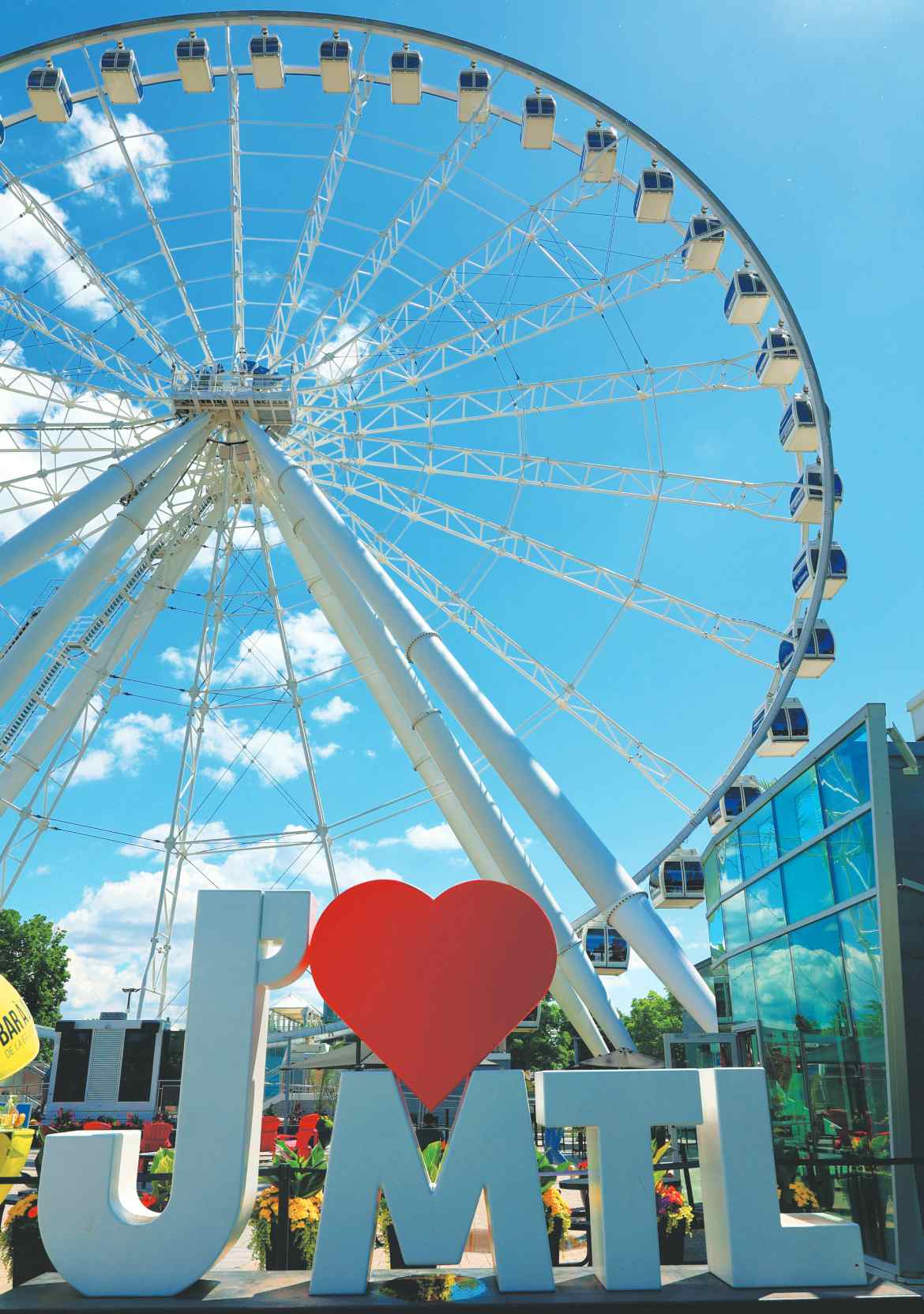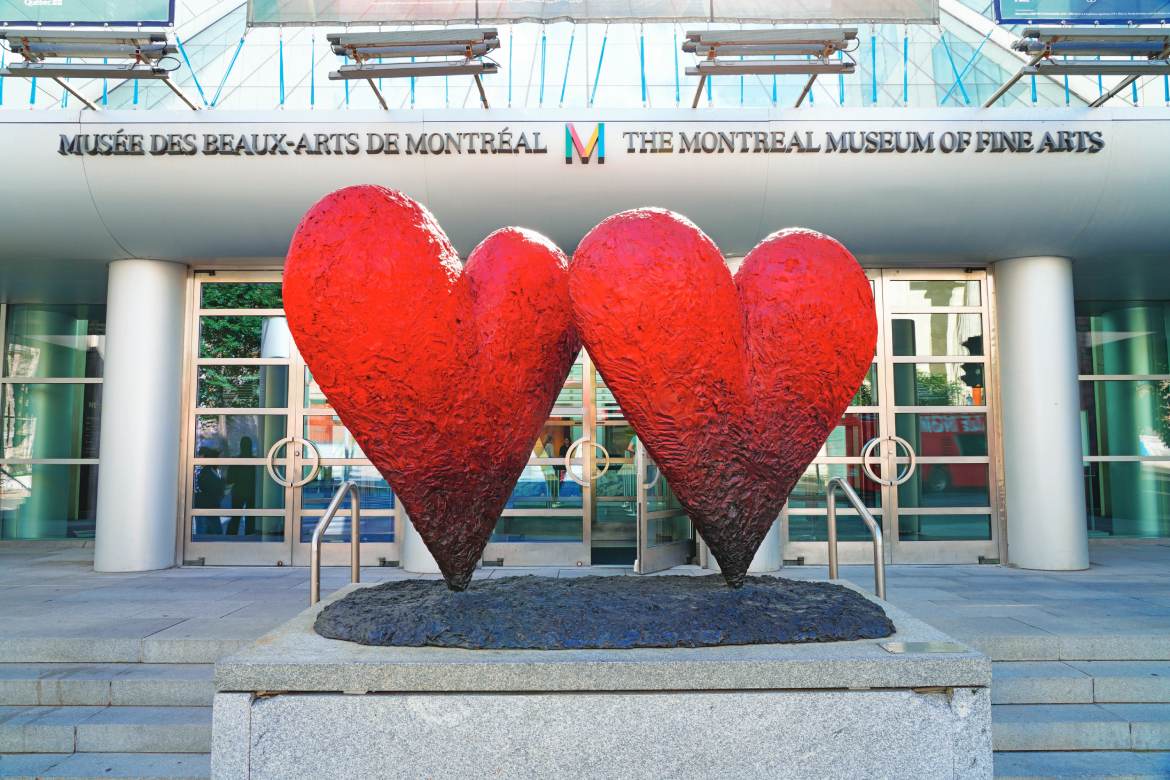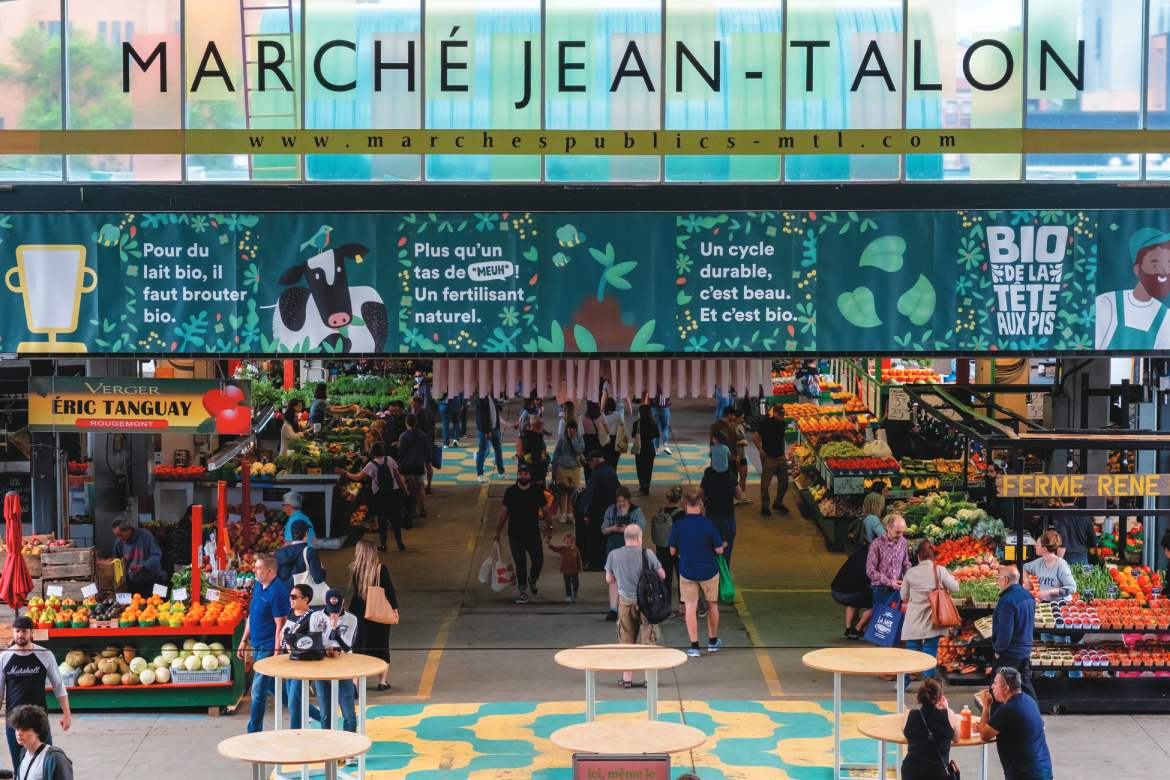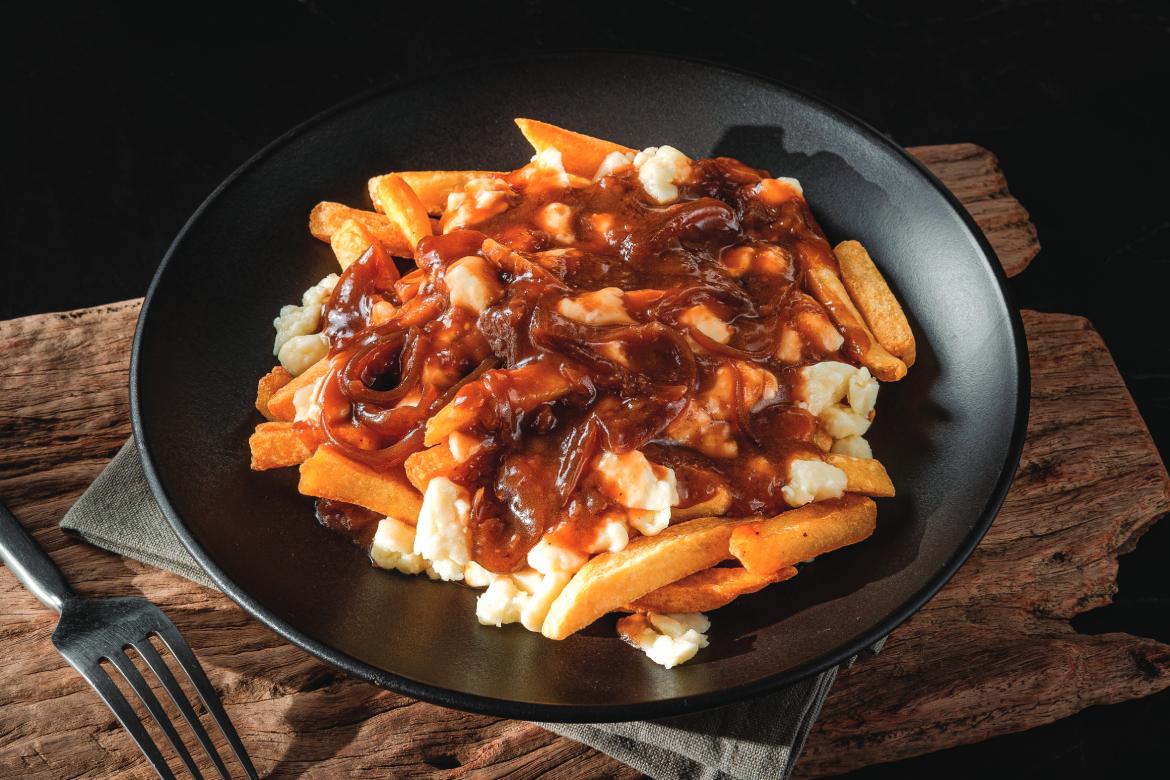
Over the course of nearly four centuries, Montréal keeps feeling younger.
Even in Vieux-Montreal, the Old Town, strolling 17th-century cobblestone lanes may lead to a futuristic art exhibit, a nouveau speakeasy, or a strikingly modern chef’s table. This young-within-old phenomenon may not be unique to Montreal, but it’s a reason to let the city’s joie de vivre lure you up north.
I’ve traveled to the City of Saints more than any other non-domestic city, but this time it felt more exciting than ever. I got to flex my passport, albeit at a familiar Canadian border, and I could practice my rudimentary French with a Quebecois accent. Plus I was eager to reconnect with the effervescent local LGBTQ+ scene along St. Catherine in Le Village, over in Mile End, Little Italy, and all over town.
Diving into a city of rich neighborhoods takes a little strategic planning to make the most of each day while exploring the top sights, shops, and restaurants. Day one brought me to Vieux-Montreal to reconnect with the city’s heritage, starting with Place Jacques-Cartier, a European-style plaza lined with restaurants and programmed with seasonal events and public-art installations. It’s an anchor for visitors learning the streets around the prominent landmarks of Montreal City Hall, Notre-Dame Basilica of Montreal, and silver-domed Bonsecours Market (350 Saint-Paul St. E. Tel: 514-872-5547. marchebonsecours.qc.ca), the latter filled with indie boutiques, cafés, and art galleries.

La Grande Roue de Montreal (Photo by Meunierd)
Stroll down the hill to visit the Old Port, which has gotten more polished (and touristed) with the addition of the La Grande Roue de Montreal, a huge ferris wheel with panoramic views towering over the St. Lawrence River. It’s a lovely stroll along the waterfront promenade and winding through the picturesque streets, which led me to artisanal café Olive + Gourmando (351 Saint-Paul St. W. Tel: 514-350-1083. oliveetgourmando.com) for perfect coffee and a fresh baked treat.
A few blocks away, the Montreal Museum of Archaeology and History (350 Place Royale. Tel: 514-872-9150. pacmusee.qc.ca), also called the Pointe-à-Callière Museum, schooled me on the city’s founding, which occurred on that now-landmarked site in 1642. The archaeological remains of the original fort are a highlight, along with the First Nations artifacts, and temporary exhibits highlighting global cultures.
Embracing history with a contemporary edge is the story of PHI Foundation (315 Saint-Paul St. W. Tel: 514 225-0525. phi.ca), founded in 2007 by Phoebe Greenberg, and now one of my favorite places in Montreal. It’s a fluid art space housed in an art-deco building, exhibiting site specific installations across different rooms, floors, and satellite spaces. PHI binds the neighborhood’s old architecture to modern creativity, embracing interactivity and diversity with the help of guest curators and daring programming. (Just be sure to reserve your timed tickets in advance because they often sell out.)
Revived with artistic vibes, I walked to Restaurant Melisse (719 William St. Tel: 514-379-3794. restaurantmelisse.com) for dinner. This airy space complements the Mediterranean-leaning menu of seafood and seasonal vegetables, with dishes like grilled oyster mushrooms, spectacular tzatziki and skewers, and Arctic char a la plancha. The delightful servers invited me back for weekend brunch, one of the city’s best. I wrapped up my evening in Vieux-Montreal with a gourmet nightcap at the Coldroom (Saint-Vincent St.Tel: 514-294-6911. thecoldroommtl.com), a romantic little speakeasy tucked in a basement off St. Amable.
My home base during this trip was the newly converted Hyatt Place Montreal-Downtown (1415 St-Hubert St. Tel: 514-842-4881. hyatt.com), formerly the Hotel Place Dupuis. Reopened in 2022, this new Hyatt Place has a brilliant central location between the buzzy Village and Quartier des Spectacles cultural district, plus it’s just a block from Montreal’s largest Metro station, Berri-UQAM. Thirty floors tall, the hotel offers great views, plus spacious, modern guestrooms, an indoor pool, big fitness center, lounges, and an excellent breakfast (included with most rates).

Musee des Beaux-Arts de Montreal (Museum of Fine Arts MMFA Photo by EQ Roy)
Even in Vieux-Montreal, the Old Town, strolling 17th-century cobblestone lanes may lead to a futuristic art exhibit, a nouveau speakeasy, or a strikingly modern chef’s table.
A quick Metro ride kicked off my next day, leading me to the GuyConcordia stop at the west end of Downtown. The walkable neighborhood is home to lots of shopping and hotels, along with some of the city’s major attractions, including the Montreal Museum of Fine Arts (1380 Sherbrooke St. W. Tel: 514-285-2000. mbam.qc.ca); the Montreal Museum of Contemporary Arts (Place Ville Marie. Tel: 514-847-6226. macm.org); and the marvelous Mary, Queen of the World Cathedral (1085 Cathédrale St.. Tel: 514-866-1661).
Nearby is one of the city’s most luxurious accommodations, the historic Hotel Fairmont The Queen Elizabeth (900 René-Lévesque Blvd W. Tel: 514-861-3511. fairmont.com), famous as the site of John Lennon and Yoko Ono’s 1969 week-long “bed-in” to protest the Vietnam War, and where they recorded the legendary song, “Give Peace a Chance.” Just up on Sherbrooke Street, I discovered the social, artistic, and cultural stories shared at the McCord Stewart Museum (690 Sherbrooke St. W. Tel: 514-861-6701. musee-mccord-stewart.ca). For a relatively compact museum, the exhibits share expansive works by bold, diverse artists from the past two centuries, with an emphasis on photography. The permanent exhibit, “Indigenous Voices of Today: Knowledge, Trauma, Resilience,” is exceptional, and enlightens visitors about the experiences of native peoples of Quebec and Canada through carefully selected objects and personal stories.
From indigenous history to LGBTQ+ his/herstory, next I had a rendezvous with Thom Seivewright, founder and ace guide of Tours Montreal (toursmontreal.com). For his one-of-a-kind Queer story Tour, Seivewright personally researched and curated a remarkably edifying three-hour walking tour that recounts some of the sordid, wild, weird, and disco-fabulous local heritage. The first revelation is that much of Montreal queer history is rooted in Downtown West, not the Village, where decades ago police, citizens, and local government were sometimes viciously anti-gay and anti-trans.
Through interviews with locals who survived some of the most difficult clashes and protests, Seivewright shares photos and stories not heard on any other tour. He also injects glittery true stories about the “LGBTQ2+” community’s triumphs that paved the way for the more progressive Montreal that we know and love today. (Side note: The “2” or “2S” in the Canadian queer acronym represents the “two spirit” gender/orientation that originated in indigenous cultures.)
Still thinking about Montreal’s newly fascinating queer history, I headed back to the Village to soak up today’s LGBTQ+ culture. I soon found myself dining La Tendresse (1259 St. Catherine St. E. Tel: 438-387-1471. bistrotendresse.com), one of the best vegetarian restaurants in town, with dishes of international flavors, from sweet-potato gnocchi to tamarind bean tacos to light tofu-veggie dumplings. Just up the way is Bar Renard (1272 St. Catherine St. E. Tel: 514-903-0648. barrenard.com), a chic lounge with refined cocktails, small bites, late-night fun, plus an outdoor patio on St. Catherine for prime people-watching.

Jean-Talon Market (Photo by Marc Bruxelle)
An easy 2 train Metro ride the following morning led me to the Jean Talon station, where I set out to wander the aisles of the famous Jean Talon Public Market (7070 Henri Julien Ave. marchespublicsmtl.com/marches/jean-talon). I learned a lot about the fresh farmers’ goods and artisan wares here a while back while on a food walking tour led by queer-owned Spade & Palacio (spadeandpalacio.com), and also how the market is a staple destination for special Montreal treats and edible souvenirs.
Conveniently, the Jean Talon is a hub for Little Italy and Mile-Ex, where I head for lunch and a bit of day drinking at modern tavern Brasserie Harricana (95 Jean-Talon St. W. Tel: 514-303-3039. brasserieharricana.com). Owner Marie-Pier Veilleux opened this brewery in 2015, creating a warm neighborhood microbrewery for locals to sip a range of familiar, seasonal, and unexpected beers perfect for tasting flights. The down-home food menu, however, rivals the beer selection, featuring an incredible lobster roll, thick burgers, and tasty vegetarian options.
Afterwards, a nice long walk seemed in order, so I roamed down St. Laurent, one of Montreal’s all-time great boulevards, towards Mile End. Restaurants, shops, and bars line the blocks, including one of my favorite beyond-the-Village gay bars, Notre Dame des Quilles (32 Beaubien St. E. Tel: 514-757-7415), a somewhat zany space with comedy, drag, and other live shows, and two old-school bowling lanes that explain its English name: Our Lady of Bowling. On the east side of Mile End, adorable wine bar Buvette Chez Simone (4869 Park Ave. Tel: 514-750-6577. buvettechezsimone.com) is another queer-friendly must, pouring delicious vintages alongside charcuterie boards and hearty snacks.
On my way back towards the Village, I picked up a bag of famous, sesame-crusted St. Viateur Bagels (263 St. Viateur St. W. Tel: 514-276-8044. tviateurbagel.com) from its original storefront, so I could relive Montreal memories back home. A bit of browsing at Annex Village (5364 St Laurent Blvd. Tel: 514-903-4404. annexvintage.com) scored me sweet secondhand jewelry and a wonderful fragrance, complemented by my new favorite pants at nearby Jeans Jeans Jeans (5575 Casgrain Ave. Tel: 514-279-3303. jeansjeansjeans.ca) denim emporium.
In the Village, I was sure to visit L’Euguélionne (1426 Beaudry St. Tel: 514-522-4949. librairieleuguelionne.com), an inviting woman-owned bookshop filled with actual printed literature, new and old, French and English.

Delicious traditional Canadian Poutine with gravy, fries with cheese curd (Photo by FILMME)
My time in town was winding down, and I felt couldn’t go another moment without poutine, Montreal’s trademark comfort food of thick fries topped with cheese curds and gravy. So I dipped into Le Central (30 St. Catherine St. W. lecentral.ca), a big food hall with an array of cuisines from local vendors. Le Gras Dur, known also for BBQ and schnitzel, was my spot for pure poutine indulgence, and it was everything naughty that it could and should be.
On this enchanting journey back through one of my all-time favorite cities, I ended on a high note, sipping fine cocktails at L’Ideal Bar (151 Ontario St. E. Tel: 438-380-5761. lidealmtl.com). Opened in 2021 inside of the long beloved (but not forgotten) Jello Martini Lounge, this queer hotspot quickly made a splash drawing a flirty mixed crowd with its amazing cocktails, wine, and bites. It’s often programmed with tasting parties, guest DJs, and drag shows, and even records an on-site podcast series, inviting patrons to chime in. The podcast wasn’t taping during my visit, but I got to record my own experience at L’Ideal from my perch at the bustling bar.
Watching the place fill up I saw Montrealer’s who, despite their age or life experience, contribute to the city’s seductively creative atmosphere. In this same space where decades of martini-loving revelers lived it up, here was a fresh energy shoring up an eternally modern Montreal.
You may also enjoy
8 Awesome Things to do in Canada’s Banff National
The post Canada’s Kinetic Cultural Capital: Montréal appeared first on Passport Magazine.
Canada’s Kinetic Cultural Capital: Montréal
Over the course of nearly four centuries, Montréal keeps feeling younger.
Even in Vieux-Montreal, the Old Town, strolling 17th-century cobblestone lanes may lead to a futuristic art exhibit, a nouveau speakeasy, or a strikingly modern chef’s table. This young-within-old phenomenon may not be unique to Montreal, but it’s a reason to let the city’s joie de vivre lure you up north.
I’ve traveled to the City of Saints more than any other non-domestic city, but this time it felt more exciting than ever. I got to flex my passport, albeit at a familiar Canadian border, and I could practice my rudimentary French with a Quebecois accent. Plus I was eager to reconnect with the effervescent local LGBTQ+ scene along St. Catherine in Le Village, over in Mile End, Little Italy, and all over town.
Diving into a city of rich neighborhoods takes a little strategic planning to make the most of each day while exploring the top sights, shops, and restaurants. Day one brought me to Vieux-Montreal to reconnect with the city’s heritage, starting with Place Jacques-Cartier, a European-style plaza lined with restaurants and programmed with seasonal events and public-art installations. It’s an anchor for visitors learning the streets around the prominent landmarks of Montreal City Hall, Notre-Dame Basilica of Montreal, and silver-domed Bonsecours Market (350 Saint-Paul St. E. Tel: 514-872-5547. marchebonsecours.qc.ca), the latter filled with indie boutiques, cafés, and art galleries.

La Grande Roue de Montreal (Photo by Meunierd)
Stroll down the hill to visit the Old Port, which has gotten more polished (and touristed) with the addition of the La Grande Roue de Montreal, a huge ferris wheel with panoramic views towering over the St. Lawrence River. It’s a lovely stroll along the waterfront promenade and winding through the picturesque streets, which led me to artisanal café Olive + Gourmando (351 Saint-Paul St. W. Tel: 514-350-1083. oliveetgourmando.com) for perfect coffee and a fresh baked treat.
A few blocks away, the Montreal Museum of Archaeology and History (350 Place Royale. Tel: 514-872-9150. pacmusee.qc.ca), also called the Pointe-à-Callière Museum, schooled me on the city’s founding, which occurred on that now-landmarked site in 1642. The archaeological remains of the original fort are a highlight, along with the First Nations artifacts, and temporary exhibits highlighting global cultures.
Embracing history with a contemporary edge is the story of PHI Foundation (315 Saint-Paul St. W. Tel: 514 225-0525. phi.ca), founded in 2007 by Phoebe Greenberg, and now one of my favorite places in Montreal. It’s a fluid art space housed in an art-deco building, exhibiting site specific installations across different rooms, floors, and satellite spaces. PHI binds the neighborhood’s old architecture to modern creativity, embracing interactivity and diversity with the help of guest curators and daring programming. (Just be sure to reserve your timed tickets in advance because they often sell out.)
Revived with artistic vibes, I walked to Restaurant Melisse (719 William St. Tel: 514-379-3794. restaurantmelisse.com) for dinner. This airy space complements the Mediterranean-leaning menu of seafood and seasonal vegetables, with dishes like grilled oyster mushrooms, spectacular tzatziki and skewers, and Arctic char a la plancha. The delightful servers invited me back for weekend brunch, one of the city’s best. I wrapped up my evening in Vieux-Montreal with a gourmet nightcap at the Coldroom (Saint-Vincent St.Tel: 514-294-6911. thecoldroommtl.com), a romantic little speakeasy tucked in a basement off St. Amable.
My home base during this trip was the newly converted Hyatt Place Montreal-Downtown (1415 St-Hubert St. Tel: 514-842-4881. hyatt.com), formerly the Hotel Place Dupuis. Reopened in 2022, this new Hyatt Place has a brilliant central location between the buzzy Village and Quartier des Spectacles cultural district, plus it’s just a block from Montreal’s largest Metro station, Berri-UQAM. Thirty floors tall, the hotel offers great views, plus spacious, modern guestrooms, an indoor pool, big fitness center, lounges, and an excellent breakfast (included with most rates).

Musee des Beaux-Arts de Montreal (Museum of Fine Arts MMFA Photo by EQ Roy)
Even in Vieux-Montreal, the Old Town, strolling 17th-century cobblestone lanes may lead to a futuristic art exhibit, a nouveau speakeasy, or a strikingly modern chef’s table.
A quick Metro ride kicked off my next day, leading me to the GuyConcordia stop at the west end of Downtown. The walkable neighborhood is home to lots of shopping and hotels, along with some of the city’s major attractions, including the Montreal Museum of Fine Arts (1380 Sherbrooke St. W. Tel: 514-285-2000. mbam.qc.ca); the Montreal Museum of Contemporary Arts (Place Ville Marie. Tel: 514-847-6226. macm.org); and the marvelous Mary, Queen of the World Cathedral (1085 Cathédrale St.. Tel: 514-866-1661).
Nearby is one of the city’s most luxurious accommodations, the historic Hotel Fairmont The Queen Elizabeth (900 René-Lévesque Blvd W. Tel: 514-861-3511. fairmont.com), famous as the site of John Lennon and Yoko Ono’s 1969 week-long “bed-in” to protest the Vietnam War, and where they recorded the legendary song, “Give Peace a Chance.” Just up on Sherbrooke Street, I discovered the social, artistic, and cultural stories shared at the McCord Stewart Museum (690 Sherbrooke St. W. Tel: 514-861-6701. musee-mccord-stewart.ca). For a relatively compact museum, the exhibits share expansive works by bold, diverse artists from the past two centuries, with an emphasis on photography. The permanent exhibit, “Indigenous Voices of Today: Knowledge, Trauma, Resilience,” is exceptional, and enlightens visitors about the experiences of native peoples of Quebec and Canada through carefully selected objects and personal stories.
From indigenous history to LGBTQ+ his/herstory, next I had a rendezvous with Thom Seivewright, founder and ace guide of Tours Montreal (toursmontreal.com). For his one-of-a-kind Queer story Tour, Seivewright personally researched and curated a remarkably edifying three-hour walking tour that recounts some of the sordid, wild, weird, and disco-fabulous local heritage. The first revelation is that much of Montreal queer history is rooted in Downtown West, not the Village, where decades ago police, citizens, and local government were sometimes viciously anti-gay and anti-trans.
Through interviews with locals who survived some of the most difficult clashes and protests, Seivewright shares photos and stories not heard on any other tour. He also injects glittery true stories about the “LGBTQ2+” community’s triumphs that paved the way for the more progressive Montreal that we know and love today. (Side note: The “2” or “2S” in the Canadian queer acronym represents the “two spirit” gender/orientation that originated in indigenous cultures.)
Still thinking about Montreal’s newly fascinating queer history, I headed back to the Village to soak up today’s LGBTQ+ culture. I soon found myself dining La Tendresse (1259 St. Catherine St. E. Tel: 438-387-1471. bistrotendresse.com), one of the best vegetarian restaurants in town, with dishes of international flavors, from sweet-potato gnocchi to tamarind bean tacos to light tofu-veggie dumplings. Just up the way is Bar Renard (1272 St. Catherine St. E. Tel: 514-903-0648. barrenard.com), a chic lounge with refined cocktails, small bites, late-night fun, plus an outdoor patio on St. Catherine for prime people-watching.

Jean-Talon Market (Photo by Marc Bruxelle)
An easy 2 train Metro ride the following morning led me to the Jean Talon station, where I set out to wander the aisles of the famous Jean Talon Public Market (7070 Henri Julien Ave. marchespublicsmtl.com/marches/jean-talon). I learned a lot about the fresh farmers’ goods and artisan wares here a while back while on a food walking tour led by queer-owned Spade & Palacio (spadeandpalacio.com), and also how the market is a staple destination for special Montreal treats and edible souvenirs.
Conveniently, the Jean Talon is a hub for Little Italy and Mile-Ex, where I head for lunch and a bit of day drinking at modern tavern Brasserie Harricana (95 Jean-Talon St. W. Tel: 514-303-3039. brasserieharricana.com). Owner Marie-Pier Veilleux opened this brewery in 2015, creating a warm neighborhood microbrewery for locals to sip a range of familiar, seasonal, and unexpected beers perfect for tasting flights. The down-home food menu, however, rivals the beer selection, featuring an incredible lobster roll, thick burgers, and tasty vegetarian options.
Afterwards, a nice long walk seemed in order, so I roamed down St. Laurent, one of Montreal’s all-time great boulevards, towards Mile End. Restaurants, shops, and bars line the blocks, including one of my favorite beyond-the-Village gay bars, Notre Dame des Quilles (32 Beaubien St. E. Tel: 514-757-7415), a somewhat zany space with comedy, drag, and other live shows, and two old-school bowling lanes that explain its English name: Our Lady of Bowling. On the east side of Mile End, adorable wine bar Buvette Chez Simone (4869 Park Ave. Tel: 514-750-6577. buvettechezsimone.com) is another queer-friendly must, pouring delicious vintages alongside charcuterie boards and hearty snacks.
On my way back towards the Village, I picked up a bag of famous, sesame-crusted St. Viateur Bagels (263 St. Viateur St. W. Tel: 514-276-8044. tviateurbagel.com) from its original storefront, so I could relive Montreal memories back home. A bit of browsing at Annex Village (5364 St Laurent Blvd. Tel: 514-903-4404. annexvintage.com) scored me sweet secondhand jewelry and a wonderful fragrance, complemented by my new favorite pants at nearby Jeans Jeans Jeans (5575 Casgrain Ave. Tel: 514-279-3303. jeansjeansjeans.ca) denim emporium.
In the Village, I was sure to visit L’Euguélionne (1426 Beaudry St. Tel: 514-522-4949. librairieleuguelionne.com), an inviting woman-owned bookshop filled with actual printed literature, new and old, French and English.

Delicious traditional Canadian Poutine with gravy, fries with cheese curd (Photo by FILMME)
My time in town was winding down, and I felt couldn’t go another moment without poutine, Montreal’s trademark comfort food of thick fries topped with cheese curds and gravy. So I dipped into Le Central (30 St. Catherine St. W. lecentral.ca), a big food hall with an array of cuisines from local vendors. Le Gras Dur, known also for BBQ and schnitzel, was my spot for pure poutine indulgence, and it was everything naughty that it could and should be.
On this enchanting journey back through one of my all-time favorite cities, I ended on a high note, sipping fine cocktails at L’Ideal Bar (151 Ontario St. E. Tel: 438-380-5761. lidealmtl.com). Opened in 2021 inside of the long beloved (but not forgotten) Jello Martini Lounge, this queer hotspot quickly made a splash drawing a flirty mixed crowd with its amazing cocktails, wine, and bites. It’s often programmed with tasting parties, guest DJs, and drag shows, and even records an on-site podcast series, inviting patrons to chime in. The podcast wasn’t taping during my visit, but I got to record my own experience at L’Ideal from my perch at the bustling bar.
Watching the place fill up I saw Montrealer’s who, despite their age or life experience, contribute to the city’s seductively creative atmosphere. In this same space where decades of martini-loving revelers lived it up, here was a fresh energy shoring up an eternally modern Montreal.
You may also enjoy
8 Awesome Things to do in Canada’s Banff National
The post Canada’s Kinetic Cultural Capital: Montréal appeared first on Passport Magazine.


Post a Comment